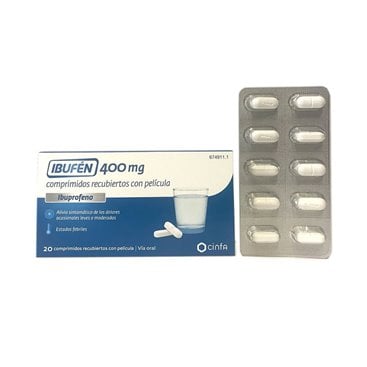Ibufen 400 Mg 20 Coated Tablets
Ibufen 400 mg coated tablets provide effective relief from mild to moderate pain, fever, and inflammation. Ideal for headaches, menstrual cramps, and muscle pain, these ibuprofen-based tablets act quickly and reliably. Purchase now on parafarmacia-online.com for fast shipping and expert support. Suitable for adults and teenagers aged 12+.
Ibufen 400 mg coated tablets provide effective relief from mild to moderate pain, fever, and inflammation. Ideal for headaches, menstrual cramps, and muscle pain, these ibuprofen-based tablets act quickly and reliably. Purchase now on parafarmacia-online.com for fast shipping and expert support. Suitable for adults and teenagers aged 12+.
Ibufen 400 Mg Coated Tablets: Fast and Reliable Pain Relief
Ibufen 400 mg coated tablets offer a trusted solution for pain, fever, and inflammation. Containing ibuprofen, a powerful nonsteroidal anti-inflammatory drug (NSAID), these tablets work quickly to alleviate discomfort from a variety of conditions, making them a go-to option for effective pain management.
What is Ibufen 400 Mg Coated Tablets Used For?
Ibufen 400 mg coated tablets are indicated for:
- Mild to moderate pain, including headaches and migraines.
- Menstrual cramps (dysmenorrhea).
- Muscle pain, such as back pain or tension.
- Dental pain and discomfort from conditions like otitis or sore throat.
- Reducing fever in adults and teens over 12 years old.
How Does Ibufen 400 Mg Coated Tablets Work?
The active ingredient, ibuprofen, reduces pain and inflammation by inhibiting prostaglandin production, compounds that cause swelling and sensitivity in the body. Taken orally, Ibufen 400 mg is absorbed quickly, providing relief within 1 to 3 hours of ingestion. Its effects can last up to 6-8 hours, depending on the dosage.
Who Can Use Ibufen 400 Mg Coated Tablets?
This product is suitable for:
- Adults and teenagers aged 12 years and older.
- Individuals experiencing mild to moderate pain.
- Patients with fever caused by infections or flu symptoms.
- Those needing short-term anti-inflammatory treatment for joint or muscle pain.
Dosage and Administration of Ibufen 400 Mg Coated Tablets
Recommended Dosage:
- Adults and teenagers: 200-400 mg every 4-6 hours as needed.
- Maximum daily dose: 1,200 mg (equivalent to three 400 mg tablets).
How to Take Ibufen:
- Swallow tablets with a glass of water.
- Take after meals to reduce potential stomach irritation.
Duration of Use:
- Pain: Do not use for more than 5 days without medical advice.
- Fever: Limit use to 3 days unless directed by a healthcare provider.
Precautions When Using Ibufen 400 Mg Coated Tablets
- Avoid if you are allergic to ibuprofen or other NSAIDs.
- Not recommended for people with active stomach ulcers or severe liver or kidney conditions.
- Consult a doctor if you are pregnant, breastfeeding, or taking other medications like blood thinners or corticosteroids.
Use cautiously in individuals over 65 years old, as they may be more susceptible to side effects such as gastrointestinal issues.
Side Effects of Ibufen 400 Mg Coated Tablets
Common side effects include:
- Stomach pain, nausea, or indigestion.
- Skin rashes or mild allergic reactions.
- Dizziness or drowsiness in prolonged treatments.
If severe reactions such as breathing difficulties, gastrointestinal bleeding, or swelling occur, stop using the product and seek immediate medical attention.
Where to Buy Ibufen 400 Mg Coated Tablets?
Purchase Ibufen 400 mg coated tablets at parafarmacia-online.com and enjoy:
- Competitive prices.
- Fast and secure delivery.
- Professional support for all your pharmaceutical needs.




